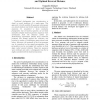64 search results - page 1 / 13 » Improving Tree Search in Phylogenetic Reconstruction from Ge... |
WEA
2007
Springer
14 years 5 months ago
2007
Springer
Abstract. A major task in evolutionary biology is to determine the ancestral relationships among the known species, a process generally referred as phylogenetic reconstruction. In ...
BMCBI
2008
13 years 11 months ago
2008
Background: Due to recent progress in genome sequencing, more and more data for phylogenetic reconstruction based on rearrangement distances between genomes become available. Howe...
CSB
2005
IEEE
14 years 4 months ago
2005
IEEE
Traditional phylogenetic tree reconstruction is based on point mutations of a single gene. This approach is hardly suitable for genomes whose genes are almost identical and hardly...
RECOMB
2005
Springer
14 years 11 months ago
2005
Springer
Abstract. Gene rearrangements have been used successfully in phylogenetic reconstruction and comparative genomics, but usually under the assumption that all genomes have the same g...
RECOMB
2007
Springer
14 years 11 months ago
2007
Springer
In the past decade, genome rearrangements have attracted increasing attention from both biologists and computer scientists as a new type of data for phylogenetic analysis. Methods ...

